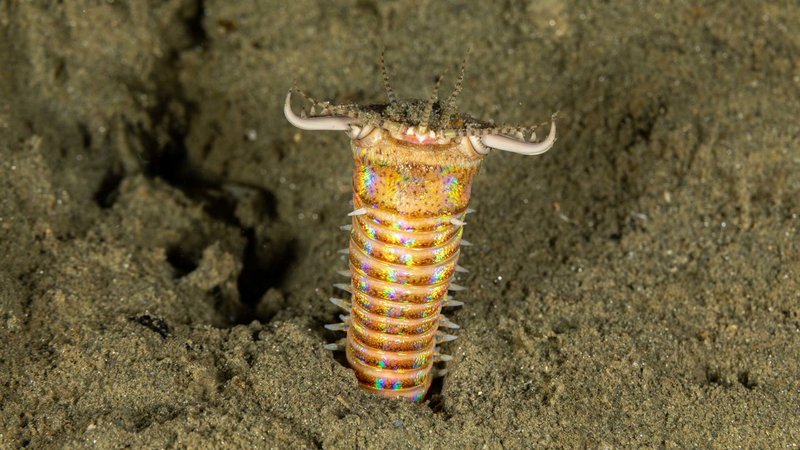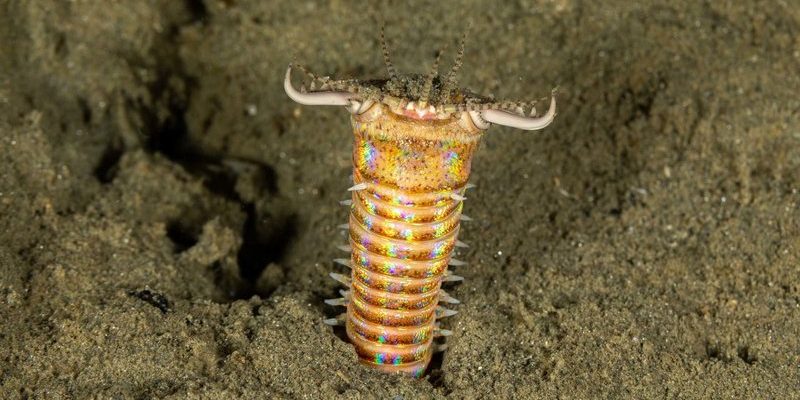
These worms may be a bit shy, often hiding in the soft sediment of the ocean floor, but they have a captivating story to tell. Documented encounters with giant bootlace worms reveal a lot about their behavior, biology, and the environments they call home. If you’re as curious about these creatures as I am, let’s dive into the fascinating world of giant bootlace worms together.
What Are Giant Bootlace Worms?
Giant bootlace worms belong to the *HimantBranchus* genus and are part of the polychaete family. These aren’t your garden-variety worms. With their long, thin, and often brightly colored bodies, they can look a bit like a spaghetti noodle that’s gotten a little too adventurous. They are segmented creatures, which means their bodies are made up of many repeating sections, each with its own set of muscles and organs. This segmentation allows them to move gracefully through the water, resembling a ribbon as they undulate.
You might be wondering why they’re called “bootlace” worms. The name comes from their resemblance to the traditional laces used on shoes—long, thin, and slightly twisted. Interestingly, while they might look delicate, these worms are surprisingly tough. They can survive in various environments, from sandy bays to rocky shores, and have even been spotted in deeper waters.
Where Do They Live?
Giant bootlace worms are primarily found in the coastal waters of New Zealand and Australia. They prefer sandy or muddy substrates where they can burrow and hide. Most encounters happen during low tide when more of the beach is exposed, allowing curious explorers to find these fascinating worms.
Despite their impressive lengths, these creatures often remain hidden from view, making them a delightful surprise for anyone who stumbles across them. They typically dwell in the intertidal zone, meaning they’re comfortable in areas that are both submerged and exposed. This adaptability is key to their survival, as it allows them to evade predators and thrive in various habitats.
Documented Encounters: The Good, The Weird, and The Wonderful
Encounters with giant bootlace worms have been documented over the years, and often, they lead to some pretty intriguing stories. *Imagine a group of marine biologists out on a research expedition and suddenly spotting one of these massive worms squirming in the sand.* It’s moments like these that create excitement and curiosity in the scientific community.
One famous encounter involved a fisherman who reeled in a particularly long giant bootlace worm while fishing near a reef. As he pulled it out of the water, the worm unwound and extended, catching everyone off guard. *It’s not every day you see a creature that looks like a mythical sea serpent!* Stories like these contribute to the fascination surrounding these marine organisms.
While many encounters can be awe-inspiring, others can be downright bizarre. For example, some divers have reported feeling a slight tug against their legs while exploring underwater, only to turn and find a giant bootlace worm playfully moving around them. It’s moments like these that remind us of the wonder of nature and the unique behaviors of marine life.
How They Interact with Their Environment
Giant bootlace worms play a crucial role in their ecosystems. These worms feed on organic materials found in the sediment, such as decaying plant matter and small invertebrates. By breaking down this organic matter, they help recycle nutrients back into the ecosystem, which benefits other marine life.
Moreover, their burrowing behavior helps aerate the sediment, allowing better water circulation. This process supports a healthier habitat for various marine organisms, from fish to crustaceans. In essence, giant bootlace worms are unsung heroes of the ocean floor, doing important work that often goes unnoticed.
Mysteries and Myths Surrounding Giant Bootlace Worms
With any fascinating creature comes a swirl of myths and tales. One common myth is that giant bootlace worms can deliver a painful sting. While they can release a substance that might cause irritation, they are generally harmless to humans. Their primary defense mechanism is to hide away, rather than confront potential threats.
Another interesting aspect is the way they reproduce. Bootlace worms are hermaphrodites, meaning they have both male and female reproductive organs. During mating, two worms will intertwine and exchange genetic material, which is a lovely scene reminiscent of a dance. This reproductive strategy is quite fascinating and speaks to the complexity of their biology.
It’s worth noting that giant bootlace worms are also studied for their unique physiological traits. Scientists are looking into the potential applications of their biological traits for medical and environmental research. Their robust nature and ability to thrive in various environments make them worthy of study beyond the ocean floor.
How to Spot a Giant Bootlace Worm
If you ever find yourself in coastal waters where these amazing creatures live, you might be lucky enough to spot one. Here are a few tips to help you identify a giant bootlace worm:
- Look for their distinctive colors: They can be bright red, yellow, or green, making them stand out against the sandy substrate.
- Watch for movement: These worms are often seen undulating in the water or wriggling in the sand, especially during low tide.
- Keep an eye out for their length: While typical earthworms are short, giant bootlace worms can stretch impressively long, more than a few meters in some cases.
If you do spot one, take a moment to appreciate this incredible creature. Just remember to keep a respectful distance—after all, they might not enjoy the spotlight as much as we do!
Conservation and the Future of Giant Bootlace Worms
As with many marine species, giant bootlace worms face threats from habitat destruction and pollution. Coastal development can disrupt their living environments, while pollution can affect the quality of the water they inhabit. Conservation efforts focusing on preserving coastal ecosystems are vital to ensuring these unique creatures continue to thrive.
Awareness is key. By understanding and sharing the importance of these worms within their ecological niche, we can help promote efforts aimed at protecting their habitats. Every bit of effort counts, whether from individual actions or community-led initiatives aimed at safeguarding marine environments.
In addition, researchers continue to study giant bootlace worms to better understand their biology and ecology. Their findings could provide insights into broader environmental issues, helping inform conservation strategies for various marine life.
Why Giant Bootlace Worms Matter
So, why should we care about giant bootlace worms? These creatures may seem niche, but they represent a larger picture of marine biodiversity. Each organism in an ecosystem plays a role, and losing one can have far-reaching consequences. By learning more about bootlace worms, we can foster a deeper appreciation for the incredible complexity of ocean life.
Ultimately, giant bootlace worms remind us of the wonders beneath the waves. They play a significant role in their ecosystems and offer a glimpse into the bizarre and beautiful life forms that call our oceans home.
In closing, whether you’re a seasoned marine biologist or a curious beachcomber, the world of giant bootlace worms is rich with intrigue. Next time you’re by the shore, keep an eye out—you never know what fascinating creatures you might encounter!

